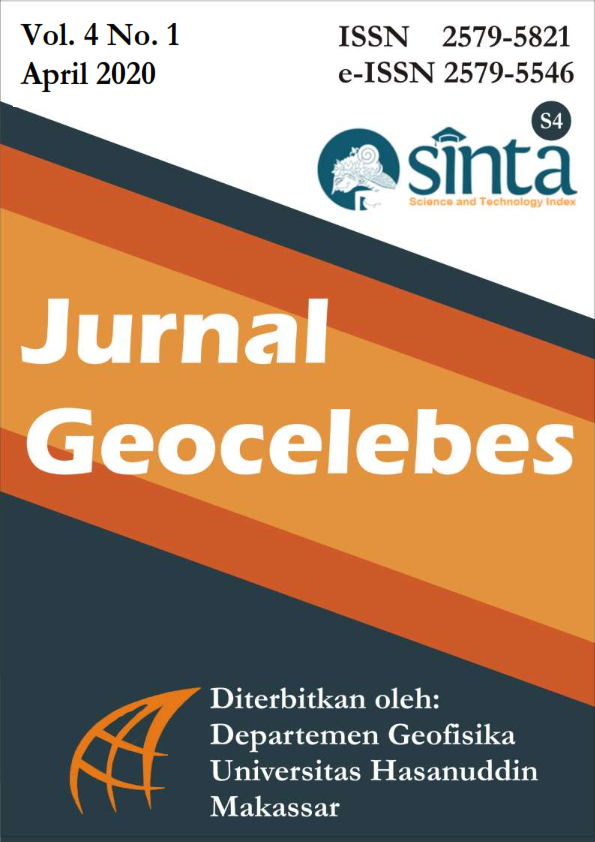CHARACTERIZATION OF SOIL THERMAL PROPERTIES FOR DESIGN OF UNDERGROUND CABLE ROUTES AT THE WIND FARM POWER PLANT AREA, PANYIPATAN AND PELAIHARI SUB-DISTRICT, SOUTH KALIMANTAN
DOI:
https://doi.org/10.20956/geocelebes.v4i1.9599Abstract
The estimation of soil thermal resistivity is essential for many types of big engineering projects because of the required knowledge about subsurface transmission of either heated fluids or high power currents. Thermal conductivity measurements were carried out at 12 locations, eight measurement point locations in South Kalimantan, the Sapu Angin hill region, sub-district Penyipatan and four points in the area of Kampung Baru, sub-district Pelaihari made at 2-3 variations in depth of 50 to 100 cm, which adjusted to the ability of the soil drilling support equipment to make holes in the soil. Samples were also collected from the locations for physical parameters description that influences thermal resistivity, subjected to grain size distribution and compaction analysis. The calculation of thermal conductivity is done by using CT-Lab software ver. 1.0.2 with a sensor resistance value of 82.69 ohms / m, heater voltage 4.0 V, and heater power 4.3857 W/m. The results show that the thermal conductivity values range from 0.593 to 3.239 W/mK. For the Sapu Angin hill region, sub-district Penyipatan, soil layers are generally in the form of sandy-clay (λ> 1.2 W/mK), but at some points, the value of thermal conductivity in these layers have decreased (λ <1.2 W/mK) due to rainwater infiltration (BH-02, BH-03, BH-04, BH-05, and BH-07). The infiltration causes weakening or loosening of bonds between the constituent particles of the soil. While in the area of Kampung Baru sub-district Pelaihari, the soil layer is generally in the form of sandy-clay, which has not well compacted (BH-08, BH-10, BH-12) with high water content (BH-09).Downloads
References
American Society for Testing and Materials (2005) ‘Standart Test Method for Determination of Thermal Conductivity of Soil and Soft Rock by Thermal Needle Probe Procedure D 5334-08’, ASTM International, 04, pp. 1–6. doi: 10.1520/D5334-08.2.
Côté, J. and Konrad, J. M. (2005) ‘A generalized thermal conductivity model for soils and construction materials’, Canadian Geotechnical Journal, 42(2), pp. 443–458. doi: 10.1139/t04-106.
Dali Naidu, A. and Singh, D. N. (2004) ‘A generalized procedure for determining thermal resistivity of soils’, International Journal of Thermal Sciences, 43(1), pp. 43–51. doi: 10.1016/S1290-0729(03)00103-0.
Darlan, Y. et al. (1999) Studi Regional Cekungan Batubara Wilayah Pesisir Tanah Laut – Kotabaru, Direktorat Sumberdaya Mineral, Kementerian ESDM.
G.V. Herzen and Maxwell, A. E. (1959) ‘The measurement of thermal conductivity of Deep-Sea Sediments by a Needle-Probe Method’, Journal of Geophysical Research, 64(10), pp. 1557–1563. doi: 10.1098/rspa.1923.0095.
Lilliestierna, A. and Utas, J. (2015) Thermal classification of cable route, Department of Civil and Environmental Engineering Division of GeoEngineering CHALMERS UNIVERSITY OF TECHNOLOGY.
Malmedal, K., Bates, C. and Cain, D. (2014) ‘The measurement of soil thermal stability, thermal resistivity, and underground cable ampacity’, Papers Presented at the Annual Conference - Rural Electric Power Conference. doi: 10.1109/REPCon.2014.6842210.
Van Rooyen, M. and Winterkorn, H. F. (1957) Theoretical and Practical Aspects of the Thermal Conductivity of Soils and Similar Granular Systems, Highway Research Board Bulletin 168 - Fundamental and Practical Concepts of Soil Freezing. Available at: http://trid.trb.org/view.aspx?id=128127.
Sundberg, J. (1988) Thermal properties of soils and rocks, Göteborg: Chalmers University of Technology and University of Göteborg.
Vasile, M. and Vespremeanu-Stroe, A. (2017) ‘Thermal Weathering and Distribution of Mountain Rockwalls’, in Thermal Weathering and Distribution of Mountain Rockwalls, pp. 765–820. doi: 10.1007/978-3-319-32589-7.
Zhang, N. and Wang, Z. (2017) ‘Review of soil thermal conductivity and predictive models’, International Journal of Thermal Sciences. Elsevier Masson SAS, 117, pp. 172–183. doi: 10.1016/j.ijthermalsci.2017.03.013.
Downloads
Published
How to Cite
Issue
Section
License
Authors who publish with this journal agree to the following terms:
- Authors retain copyright and grant the journal right of first publication with the work simultaneously licensed under a Creative Commons Attribution License that allows others to share the work with an acknowledgement of the work's authorship and initial publication in this journal.
- Authors are able to enter into separate, additional contractual arrangements for the non-exclusive distribution of the journal's published version of the work (e.g., post it to an institutional repository or publish it in a book), with an acknowledgement of its initial publication in this journal.
- Authors are permitted and encouraged to post their work online (e.g., in institutional repositories or on their website) prior to and during the submission process, as it can lead to productive exchanges, as well as earlier and greater citation of published work (See The Effect of Open Access).



